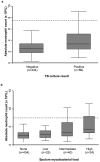Blood neutrophil counts in HIV-infected patients with pulmonary tuberculosis: association with sputum mycobacterial load
- PMID: 23874476
- PMCID: PMC3706476
- DOI: 10.1371/journal.pone.0067956
Blood neutrophil counts in HIV-infected patients with pulmonary tuberculosis: association with sputum mycobacterial load
Abstract
Background: Increasing evidence suggests that neutrophils play a role in the host response to Mycobacterium tuberculosis. We determined whether neutrophil counts in peripheral blood are associated with tuberculosis (TB) and with mycobacterial load in sputum in HIV-infected patients.
Methodology/principal findings: Adults enrolling in an antiretroviral treatment (ART) clinic in a Cape Town township were screened for TB regardless of symptoms. Paired sputum samples were examined using liquid culture, fluorescence microscopy, and the Xpert MTB/RIF assay. Absolute neutrophil counts (ANC) were measured in blood samples. Of 602 HIV-infected patients screened, 523 produced one or more sputum samples and had complete results available for analysis. Among these 523 patients, the median CD4 count was 169×10(9)/L (IQR, 96-232) and median ANC was 2.6×10(9)/L (IQR, 1.9-3.6). Culture-positive pulmonary tuberculosis was diagnosed in 89 patients. Patients with TB had a median ANC of 3.4×10(9)/L (IQR, 2.4-5.1) compared to 2.5×10(9)/L (IQR, 1.8-3.4) among those who were culture negative (p<0.0001). In multivariable analyses, having pulmonary TB was associated with an adjusted risk ratio (aRR) of 2.6 (95%CI, 1.5-4.5) for having an ANC level that exceeded the median value (ANC ≥2.6×10(9)/L; p = 0.0006) and an aRR of 6.8 (95%CI, 2.3-20.4) for having neutrophilia defined by a neutrophil count exceeding the upper limit of the normal range (ANC >7.5×10(9)/L; p = 0.0005). Patients were then classified into four mutually exclusive groups with increasing sputum mycobacterial load as defined by the results of culture, Xpert MTB/RIF and sputum smear microscopy. Multivariable analyses demonstrated that increasing sputum mycobacterial load was positively associated with blood ANC ≥2.6×10(9)/L and with neutrophilia.
Conclusions/significance: Increased blood neutrophil counts were independently associated with pulmonary TB and sputum mycobacterial burden in this HIV-infected patient group. This observation supports the growing body of literature regarding the potential role for neutrophils in the host response to TB.
Conflict of interest statement
Figures




References
-
- Lowe DM, Redford PS, Wilkinson RJ, O’Garra A, Martineau AR (2012) Neutrophils in tuberculosis: friend or foe? Trends in Immunology 33: 14–25 doi:10.1016/j.it.2011.10.003 - DOI - PubMed
-
- Eum S-Y (2010) Neutrophils Are the Predominant Infected Phagocytic Cells in the Airways of Patients With Active Pulmonary TB. Chest 137: 122 doi:10.1378/chest.09-0903 - DOI - PMC - PubMed
-
- Martineau AR, Newton SM, Wilkinson KA, Kampmann B, Hall BM, et al. (2007) Neutrophil-mediated innate immune resistance to mycobacteria. J Clin Invest 117: 1988–1994 doi:10.1172/JCI31097 - DOI - PMC - PubMed
-
- Lawn SD, Zumla AI (2011) Tuberculosis. Lancet 378: 57–72 doi:10.1016/S0140-6736(10)62173-3 - DOI - PubMed
-
- Martineau AR, Timms PM, Bothamley GH, Hanifa Y, Islam K, et al. (2011) High-dose vitamin D3 during intensive-phase antimicrobial treatment of pulmonary tuberculosis: a double-blind randomised controlled trial. The Lancet 377: 242–250 doi:10.1016/S0140-6736(10)61889-2 - DOI - PMC - PubMed
Publication types
MeSH terms
Grants and funding
LinkOut - more resources
Full Text Sources
Other Literature Sources
Medical
Molecular Biology Databases
Research Materials

